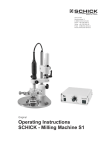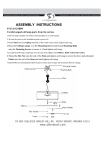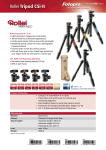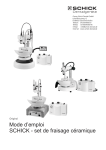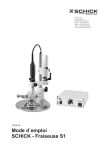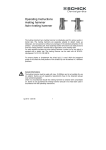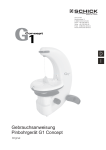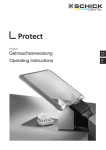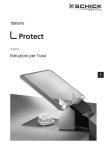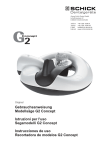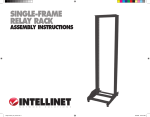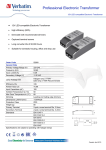Download Operating Instructions SCHICK - Milling Machine S1
Transcript
Georg Schick Dental GmbH Lehenkreuzweg 12 D-88433 Schemmerhofen Telefon Telefax E-Mail Internet +49 7356 9500-0 +49 7356 9500-95 [email protected] www.schick-dental.de Original Operating Instructions SCHICK - Milling Machine S1 SCHICK - Milling Machine S1 Index: 1. Range of Applications 2. General informations Caution ! ! 3. Setting up/operating the unit/exchanging the rotary instruments 4. Replacing the chuck 5. Maintenance and care - Replacing the carbon brushes 6. Possibel Faults 7. Technical Data 8. Milling Machine S1 9. Accesory 10. Decleration of Conformity 1. Range of Applications The S1 milling machine is intended for use in dental laboratories. It includes a milling arm which is easily moved in three dimensions. This milling machine can be used for the materials usually employed in dental laboratories, such as waxes, plasters, acrylics, metal etc. 2. General Information 2.1 Ascertain that your mains supply coincides with the data on the rating plate. 2.2 S1 milling machines are not suitable for the following applications: - in areas where there is a risk of explosion. 2.3 Ensure that all regulatory requirements are observed during use (always wear protective glasses). 2.4 Under no circumstances should the milling machine be cleaned with compressed air. 2.5 To retain the precision of the chuck and prolong ist service life, it must always be fitted with a rotary instrument or the rod supplied with the unit (even when not in use). 2.6 Recycling WEEE-Reg.-Nr. DE 78620387 Caution: ! - When using rotary instruments, do not exceed the maximum speeds laid down by their manufacturer. - repairs and other technical procedures must only be carried out by SCHICK or other suitable qualified personnel, authorized by SCHICK. - SCHICK do not guarantee the S1 milling machine should it not have been used in accordance with the operating instructions. 2 3. Setting up / Operating the unit / exchanging the rotary instruments 3.1 Ascertain that your mains supply coincides with the data on the rating plate. 3.2 Plug the unit into a mains socket. 3.3 Operating the unit (compare page 7) - switch the main supply on (1) - place the model table (5) on the platform (6) - turn the eccentric lever (2) - to lock the model table into position - move switch (3) to set the milling spindle to clockwise or anti-clockwise rotation - the control knob (4) is used to select (stepless) the rpm. 3.4 Vertical adjustment of the jointed arm - grip the jointed arm, unlock the knurled knob (12) and position the arm as required. Lock the knurled knob (12) 3.5 Securing the jointed arm in position - the jointed arm can be locked into place as required by locking or unlocking the clamping levers (9) and (10). 3.6 Working with the vertical rig - the clamping knob (13) should be unlocked for drilling - by pulling down the motor a vertical movement of the rig can be carried out. The maximum vertical distance of the rig is 24mm. Should the clamping knob (13) be locked whilst the rig is being moved vertically, the milling spindle will be locked at this level. The knurled knob (7) is a depth stop and can be adjusted individually about the metric thread around the same drilling depths to repeat. - the jointed arm can be moved both horizontally and vertically if clamping levers (9) and (10) are unlocked. 3.7 Tightening the milling spindle of the motor/ exchanging the rotary instrument ! The motor must be switched off before exchanging the rotary instrument ! - turn the chuck lever (8) as far as possible to the right (”open”) and insert the instrument. - turn the chuck lever (8) as far as possible to the left (”close”) to tigthen the instrument into place. - turning the chuck lever (8) approximately half way to the right (”open”) prevents the milling spindle rotating yet grips the instrument securely. This position is intended for gripping a trimming instrument. 3 3. Setting up / Operating the unit / exchanging the rotary instruments 3.8 Surveying spindle - Unscrew the knurled knob (11) - Withdraw the milling spindle - Insert the surveying spindle (17a) or optional (17a) into milling spindle holder and tighten the knurled knob (11) 4. Replacing the chuck - Unscrew the knurled knob (11) Withdraw the milling spindle Turn the chuck lever (8) as far as possible to the right (”open”) Unscrew the union nut (18) completely (if necessary, use a 2,35 mm diameter (20) tungsten carbide cutter shank) and pull the milling spindle off the motor. - Use a No. 4115 chuck wrench to jerk the chuck (24) anti-clockwise and unscrew it completely. If necessary, hold the tongue (21) (on the motor) with a No. 4113 wrench. Please note: In the chuck is a stroke for short shafts, this could be removed or replaced as required. - Grease the chuck (24) lightly and insert it into the shaft. Use the wrenches as described previously to screw the chuck in clockwise. Screw it in as far as possible and then tigthen it slightly. - Prior to inserting the chuck, clean it and the shaft thoroughly as otherwise the concentricity may be adversely affected. - Press the milling spindle onto the motor and tighten the union nut (18). - Insert the milling spindle into the holder and tighten the knurled screw (11) 4114 Ø2,35mm 4117 Ø3,00mm 4115 stroke for pins 4918 Ø2,35mm stroke for pins 4925 Ø3,00mm 4113 18 4113 21 8 20 11 24 24 4115 4 4115 5. Maintenance and Care Caution: Do not use compressed air to clean the milling spindle ! ! The chuck should be cleaned and re-greased once in a while, depending on how dirty it is (refer to section 4). Replacing the Carbon Brushes - Unscrew the cover (30) from the motor and pull it back - Pull on the cord to remove the insert - Use your fingers to rotate the retaining springs (31) as far as possible in the direction of the arrow - Remove the old carbon brushes - Insert the new brushes, ensuring that the lugs (33) on the carbon brushes fit into the apertures (34). Do not bend the lugs. The strands (35) of the brushes must remain exposed. - Use your fingers to rotate the retaining springs (31) as far as possible over the brushes. - Replace the insert with the cord (can only be fitted in one position) - Screw the cover (30) back into place, ensuring that the cord does not become twisted 4172 carbon brush 31 35 30 32 33 34 31 6. Possible faults Should the milling spindle be overloaded or jammed, for savety reasons the unit switches itself off. To continue operating the unit, switch it “OFF” and “ON” again (switch 1). Should the unit overheat, the excess-current cut-out on the back of the controller is activated. Once the unit has resumed ist normal working temperature, the pin can be pressed in and the unit will run again at the previously set speed. Should the pin pop out repeatedly whilst the unit is in operation, the unit is defective. Should the power decrease of the motor run jerkily, check the carbon brushes. If necessary, replace them. 5 7. Technical data Technical daten S1 Junior Rated voltage: Rated frequenzy: Motor torque: Speedrange: Concentricity: 230V/ 115V/ 100V 50/60 Hz 3,6Ncm 1.000 - 30.000rpm <0,015mm chuck: Subjet to technical modification without prior notice Ø2,35mm series Ø3,0mm on request Control unit: milling machine: Width: Height: Depth: Weight: Width: Height: Depth: Weight: 200mm 320mm 225mm 2,5kg 185mm 68mm 180mm 2,5kg 8. SCHICK - Milling machine S1 17b 17a optional: 12 Measuring Spindle Art.-Nr. 2250 8 11 10 13 9 7 5 1 6 4 3 2 6 9. Accessory S1 Modeltable Art.-No. 2407/9 Separator Art.-No. 2655 Milling tray Art.-No. Coordinat table Art.-No. 2505 Light head for turbine Art.-No. 2510/1 Adaptor ring Adjustable angle Art.-No. 2506 Control for light head Art.-No. 2480 Holding tray measuring spindle Art.-No.2250 light head short Suction tube Art.-No. 2510/2 2507 Art.-No. Diamond tool set Turbine 1,6 mm (8 pcs.) Art.-No. 2660 2508 Art.-No. Art.-No. 2509 2470 Polish set 2,35 mm (3 pcs.) Art.-No. 2665 Milling set 2,35 mm (7 pcs) Art.-No. 2530 S1 Wooden Base Art.-No. 2490 Control unit cpl. Art.No 2409 control box Art.No. 2406 motor with milling spindle complete Art.No. 4100/05 S1 - Ceramic-Milling Set cpl. Art.No. 2650/11 (without S1 Junior and S1 Wooden Base) turbine Art.No 2640/1 holding clip Art.No. 2245 light head for turbine Art.No 2510/1 control for light head Art.No. 2480 cable for light head Art.No. 2485 suction tube Art.No. 2470 separator Art.No. 2655 model table Art.No 2407/9 diamond tool set for turbine 1,6mm (8pcs.) Art.-No. 2660 polish set 2,35mm (3pcs.) Art.-No. 2665 7 10. Declaration of Conformity We, GEORG SCHICK DENTAL GmbH Lehenkreuzweg 12 D-88433 Schemmerhofen declare herewith, that the product milling machine S1 2405 und 2409 is in conformity with the following provisions of Directive: 2001/95/EG 2006/42/EG 2006/95/EG 2004/108/EG Name and adress of person in charge: (general product safety) (machinery directive) (low voltage directive) (EMV directive) Wolfgang Schick Lehenkreuzweg 12 88433 Schemmerhofen Schemmerhofen, im April 2010 W. Schick Geschäftsführer Georg Schick Dental GmbH Lehenkreuzweg 12 D-88433 Schemmerhofen Telefon Telefax E-Mail Internet 08/11 bg +49 7356 9500-0 +49 7356 9500-95 [email protected] www.schick-dental.de D20544 8








